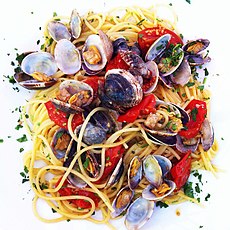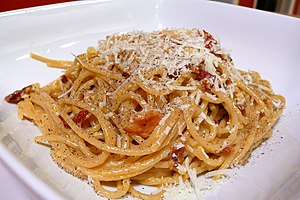Roman cuisine
 |
| Italian cuisine |
|---|
|
|
Roman cuisine is the cuisine of the Italian city of Rome. Roman cuisine is based on seasonal ingredients mostly from Roman Campagna, and prepared in a simple way.[1] Among these, the most important are vegetables (typical are peas, globe artichokes and fava beans), meat (milk lamb and goat) and cheeses (Pecorino romano and ricotta).[2] A typical condiment in Roman cuisine is strutto, pork lard prepared and canned each winter.[1] Also used is the fat of prosciutto, while olive oil is used only for raw vegetables and - occasionally - to fry.[1] Specific dishes are often assigned to the days of the week, such as gnocchi on Thursday, baccalà (salted cod) on Fridays, and trippa for Saturdays.
History

Rome's food has evolved through centuries and periods of social, cultural, and political changes. Rome became a major gastronomical center during ancient age. Ancient Roman cuisine was highly influenced by Ancient Greek culture. Subsequently, the empire's enormous expansion exposed Romans to many new, provincial culinary habits and cooking techniques. In the beginning, the differences between social classes were not very great, but disparities developed with the empire's growth. Later, during the Renaissance, Rome became well known as a center of high-cuisine, since some of the best chefs of the time worked for the popes. An example of this could be Bartolomeo Scappi, who was a chef working for Pius IV in the Vatican kitchen, reaching fame with his cookbook Opera dell'arte del cucinare, published in 1570. Here he lists approximately 1000 recipes of Renaissance cuisine and describes cooking techniques and tools, giving the first known picture of a fork.[3]
Traditional Cucina Romana
The Testaccio rione, Rome's trade and slaughterhouse area, is the place where Rome's most original and traditional foods can still be found. The area was often known as the "belly" or "slaughterhouse" of Rome, and was inhabited by butchers, or vaccinari.[4] The most common or ancient Roman cuisine included the "fifth quarter".[4] Popular foods include pig's trotters, brain, and the genitals of other animals,[4] which were often carefully cooked and richly spiced with different savouries, spices and herbs. The old-fashioned coda alla vaccinara (oxtail cooked in the way of butchers)[4] is still one of the city's most popular meals and is part of most of Rome's restaurants' menus. Lamb is also a very popular part of Roman cuisine, and is often roasted with spices and herbs.[4] There is a considerable Jewish influence in Roman cuisine, since they were many in the city, and some of the traditional meals of the ghetto date back over 400 years. Such include the carciofi alla giudia (Jewish-style artichokes) and Jewish courgettes.
Pasta in Rome
Pasta is one important element of Roman cuisine. Famous pasta sauces include amatriciana, carbonara, (a sauce made with pancetta or guanciale - pig's cheek -, cheese and egg), cacio e pepe and gricia (like carbonara but without eggs). Alfredo (invented by the chef of restaurant "Alfredo alla Scrofa") is famous abroad, but not considered traditional and mostly unheard of in Rome.
There is a pasta museum in Rome called the Museo Nazionale della Paste Alimentari (the National Museum of Pasta).[4] Rome's most common pasta shape is spaghetti, but there are many other forms.[4]
Beverages
The city is known as a centre of white wine, especially with the warm territory .Frascati and Castelli Romani are the best ones in the city.[5]
Other elements of Roman food
There are also many other dishes in Roman cuisine, including several desserts and sweets, many of which are made with ricotta cheese. Typical of Rome is the grattachecca.[4]
Bread
The smell of baking starts early in Rome about 4 AM. Nearby, in the town of Genzano, the famous Pane di Genzano is prepared in wood fired ovens that date back centuries. The bread has an IGP geographic protection and is considered one of the best breads in Rome.
Dishes

- Bruschetta - a popular antipasto or appetizer in central Italy. It comes from the Romanesco word bread which is lightly burnt, typically rubbed with garlic and topped with oil and tomatoes.
- Supplì - fried rice croquettes which are stuffed with beef ragout and mozzarella.
- Bucatini all'Amatriciana - pasta dish with tomato sauce, guanciale, and grated Pecorino Romano.[6]
- Spaghetti alla Carbonara - pasta dish with a sauce made with whipped eggs, and topped with Italian bacon, pepper and grated Pecorino Romano.
- Rigatoni con la Pajata - pasta dish with a sauce made with ringed intestines of a milk-fed veal and pecorino cheese.[7]
- Saltimbocca alla Romana - Roman-style veal with ham (prosciutto) and sage. Saltimbocca is a contraction of "salta in bocca", which literally means jump in the mouth.[8]
- Scaloppine alla romana - Veal sautéed with fresh baby artichokes
- Coda alla vaccinara - Oxtail stew, cooked with tomato sauce, celery, clove and bitter chocolate
- Carciofi alla romana - Whole artichokes filled with minced garlic and parsley and cooked in olive oil.[9]
- Carciofi alla giudia (Jewish style artichokes) Whole artichokes filled with chili peppers and deep fried.[9]
- Trippa - Tripe cooked with tomato sauce and wild mint, and topped with pecorino cheese is an ancient Roman tradition.[10]
- Fiori di Zucca - zucchini flowers filled with mozzarella cheese and anchovies, battered and deep fried.
- Abbacchio alla cacciatora - floured lamb chops cooked in oil and vinegar, spiced with garlic, sage, anchovies and rosemary [11]
- Crostata di ricotta - Is a richly baked cheesecake, made with ricotta, and flavored with lemons (or oranges) and Marsala wine.[4]
Sources
- Boni, Ada (1983) [1930]. La Cucina Romana (in Italian). Roma: Newton Compton Editori.
- Carnacina, Luigi; Bonassisi, Vincenzo (1975). Roma in Cucina (in Italian). Milano: Giunti Martello.
- Malizia, Giuliano (1995). La Cucina Ebraico-Romanesca (in Italian). Roma: Newton Compton Editori.
- Rome. Eyewitness Travel. DK Publishing. 2006. ISBN 1-4053-1090-1.
References
- ^ a b c Boni (1930), pg. 13.
- ^ Boni (1930), pg. 14
- ^ (Rolland 2006, p. 273).
- ^ a b c d e f g h i Eyewitness Travel (2006), pg. 312 - 313
- ^ Eyewitness Travel (2006), pg. 314 - 315
- ^ Boni (1930), pg. 44.
- ^ Boni (1930), pg. 150.
- ^ Boni (1930), pg. 96.
- ^ a b Boni (1930), pg. 156.
- ^ Boni (1930), pg. 94.
- ^ Boni (1930), pg. 101-2.
